The Difference Between Formal and Dynamic Equivalence

The phrase “lost in translation” exists for very good reasons.
The books that compose the Holy Bible predate Modern English by centuries. The Old Testament, which the Jewish people know as the Hebrew Bible, or Tanakh, was written in Classical Hebrew, not only a non-Indo-European language unrelated to English, but an archaic version of the reconstructed Modern Hebrew that Israelis speak today. The New Testament, on the other hand, was written in Koine Greek, the language spoken throughout greater post-Alexandrian, or Hellenistic, Greece. As with Hebrew, the Greek of the Hellenistic period is practically another language unto itself.
The vainglorious pursuit of the Tower of Babel gave us the splitting of language, and with each of those languages, a respective richness of idiom, lexicon, and grammar that does not always cross gracefully from one language to another. Anyone who would say “il pleut les chats et les chiens” to a Frenchman in a thunderstorm would receive a blank stare in return—cats and dogs only rain down upon anglophones. Conversely, non-English languages employ grammatical moods that directly express concepts such as wishes, exhortations, and unconfirmed inferences, none of which have exact equivalents in English verbs. As you read the Bible, knowing it was not first written in English, you may almost feel as if this unevenness among languages belies the universality of its original messages.
This fear led some scholars to bridge the translation gap at all costs. One such translation, Young’s Literal Translation, is so devoted to preserving the mechanics of ancient Hebrew and Greek that it presents challenges to modern readers that can be even more vexing than the antiquated but recognizably English constructions of 17th-century language. To avoid getting lost in the weeds and presenting idiosyncrasies that are sometimes almost impossible to overcome, translators most often seek one of two ideals of translation: formal equivalence or dynamic equivalence. The differences between formal and dynamic equivalence are the basis upon which you will find so many translations of the Bible, ranging from the King James Version of 1611 to The Message, finalized as recently as 2002.
Formal Equivalence
Formal equivalence in translation, broadly speaking, seeks to translate the text word-for-word, tacking as close to the original source material as the recipient language allows. In pursuing formal equivalence, translators necessarily sacrifice a degree of clarity for contemporary readers who may struggle with pronouns, conjugations, and sentence structures that don’t read as gracefully as the modern spoken word. At the other end of the continuum, even formal equivalence must bear context in mind and settle for translations of idioms that would be inscrutable to a speaker of anything but the source language.
Formal Equivalence in Bible Translations
The King James Version of the Bible, the first English translation of the Bible to achieve royal authorization and widespread distribution, is not only the best-known edition of the Bible, but also the best example of formal equivalence. A committee of Biblical scholars convened to translate from the original Hebrew and Greek as closely as possible. Not only did they do so successfully, but the English of the King James Version created idioms and turns of phrase that have endured in their own right.
While this is the most famous literal translation, it is not the most literal. That honor, such as it is, belongs to the aforementioned Young’s Literal Translation, an 1862 work of scholarship which rejects even the compromises of the KJV, boldly alleging the errancy of all prior translations with the preface “the word of God is made void by the traditions of men.” While an admirable endeavor, this translation has not found currency among laypeople—it is, however, a valuable resource for divinity students.
While their names may suggest a certain leniency relative to the other side of the pond, the American Standard Version and its revision, the New American Standard Bible, are additional examples of strict and dedicated formal equivalence. The two versions differ most significantly in their regard for the tetragrammaton, or the formal name of God: the ASV uses “Jehovah” while the NASB uses the more familiar “lord” or “god” in deference to the Jewish tradition of not using the true name of God.
Dynamic Equivalence
The counterpart to formal equivalence is dynamic equivalence, or functional equivalence. Here, rather than seeking to translate as close to word for word as possible, dynamic equivalence attempts to translate “thought for thought.” Despite the changes, or dynamics, of the text, the ideas behind the words remain intact, or functionally the same. Just as formal equivalence sacrifices clarity to retain authorial intent, dynamic equivalence sacrifices remaining true to the original text in order to be eminently readable. Dynamic equivalence is not without controversy. At its most liberal, dynamic equivalence can feel more like a paraphrasing than a translation. Let’s take, for example, John 3:16, one of the most famous verses of the Bible, as written in the formally equivalent King James Version:
“For God so loved the world, that he gave his only begotten Son, that whosoever believeth in him should not perish, but have everlasting life.”
In The Message, one of the most recent translations and an example of dynamic equivalence, and it reads thus:
“This is how much God loved the world: He gave his Son, his one and only Son. And this is why: so that no one need be destroyed; by believing in him, anyone can have a whole and lasting life.”
While the same overarching concept is evident in both translations, the dynamic equivalence of The Message raises questions: does a “whole and lasting” life go beyond life on this plane, as “everlasting” would imply? This is to say nothing of the relative artlessness of “be destroyed” over “perish,” or the clumsily didactic “this is why.”
Dynamic Equivalence in Bible Translations
Along with The Message, you can find dynamic equivalence in more recent translations of the Bible. Eugene Nida, who coined the term “dynamic equivalence,” inspired the translation known as the Good News Bible, which has been popular with children, English learners, and Protestant denominations that value the accessibility of Scripture. The most popular translation employing dynamic equivalence is the New International Version, or NIV, which has been a bestselling edition since its release in 1978 and is overwhelmingly popular among evangelical Christians.
Which Is Right for Me?
The differences between formal and dynamic equivalence are superficially easy to understand, but open the doors to a world of nuanced yet impassioned scholarly debate, as the tug of war between originality and accessibility rages on. If you, as a reader, place a premium on readily understanding key concepts, then an edition that uses dynamic equivalence is for you. On the other hand, if you want to filter out opinions and interpretations of intermediaries and stay as close to the original Hebrew and Greek as you can, you will benefit most from the formal equivalence of the King James Bible. The KJV Store offers the KJV Bible for sale, so that you may experience the word of God in all its beauty and original intent.

